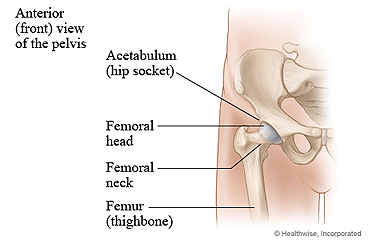
Overview
The pelvis is the ring of bones between the hips. It connects to the spine and to the leg bones at the hip joints. Blood vessels, nerves, and muscles run through the pelvic ring and can be affected by a break. A broken pelvis also can affect the organs in the pelvic area.
A broken pelvis may need a few months to heal. Your child may have had surgery to repair the pelvis, depending on where it was broken and how bad the break was. The doctor may have put metal screws, pins, or a rod in your child's pelvis to fix the break. In some cases, surgery is not needed. While the pelvis heals, your child will need to keep weight off the hips. When your child is able to walk, a walker or crutches can help. You can help your child's pelvis heal with care at home. The doctor may prescribe medicine to relieve pain and prevent blood clots.
Healthy habits can help your child heal. Give your child a variety of healthy foods. And don't smoke around your child.
Follow-up care is a key part of your child's treatment and safety. Be sure to make and go to all appointments, and call your doctor if your child is having problems. It's also a good idea to know your child's test results and keep a list of the medicines your child takes.
How can you care for your child at home?
- Put ice or a cold pack on the painful area for 10 to 20 minutes at a time. Try to do this every 1 to 2 hours for the next 3 days (when your child is awake). Put a thin cloth between the ice and your child's skin.
- Be safe with medicines. Give pain medicines exactly as directed.
- If the doctor gave your child a prescription medicine for pain, give it as prescribed.
- If your child is not taking a prescription pain medicine, ask the doctor if your child can take an over-the-counter medicine.
- Help your child put only as much weight on each leg as the doctor prescribes. Your doctor may advise that your child use crutches.
- Help your child avoid constipation.
- Include fruits, vegetables, beans, and whole grains in your child's diet each day. These foods are high in fiber.
- Give your child plenty of fluids. If your child has kidney, heart, or liver disease and has to limit fluids, talk with the doctor before you give your child more fluids to drink.
- Help your child get some exercise every day, as soon as your child is able to walk and the doctor says it is okay to exercise. Build up slowly to 30 to 60 minutes a day on 5 or more days of the week.
- Schedule time each day for a bowel movement. A daily routine may help. Ask your child to take time and not strain when having a bowel movement.
When should you call for help?
Call 911 anytime you think your child may need emergency care. For example, call if:
- Your child has chest pain, is short of breath, or coughs up blood.
Call your doctor now or seek immediate medical care if:
- Your child has new or worse pain.
- Your child's foot is cool or pale or changes color.
- Your child has tingling, weakness, or numbness in the foot and toes.
- Your child has signs of a blood clot in the leg (called a deep vein thrombosis), such as:
- Pain in the calf, back of the knee, thigh, or groin.
- Redness or swelling in the leg.
Watch closely for changes in your child's health, and be sure to contact your doctor if:
- Your child does not get better as expected.
Where can you learn more?
Go to http://www.healthwise.net/patientEd
Enter F677 in the search box to learn more about "Broken Pelvis in Children: Care Instructions".
Current as of: July 31, 2024
Author: Ignite Healthwise, LLC Staff
Clinical Review Board
All Ignite Healthwise, LLC education is reviewed by a team that includes physicians, nurses, advanced practitioners, registered dieticians, and other healthcare professionals.

